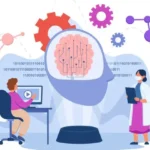In today’s world, everything is turning digital: manufacturing, retail, and agriculture. The global digital transformation market is set to reach a worth of $1009.8 billion by 2025, according to a report from Grand View Research, and this is one of the many reasons why technology has turned out to be the go-to method for streamlining operations, creating efficiency, and unlocking new possibilities. Development teams-specialized groups of tech talents-are at the heart of this transformation, moving material digitisation forward. Their influence is experienced across many industries, redefining how firms approach innovation, sustainability, and customer interaction.
The Role of Dedicated Development Teams in Material Digitization
The consistency, expertise, and focus that dedicated development teams can bring often provide the necessary impetus for an in-depth tackle of these complexities of material digitisation. It is not all about coding; in fact, it is about teams made up of project managers, analysts, engineers, and designers who integrate digital technologies into material handling and processing.
Why a Dedicated Team?
Choosing a dedicated team model for digitisation projects offers several advantages:
- Consistency and Commitment: Your project’s dedicated development team is fully immersed in it, ensuring a consistent pace and directional focus that is not easily disrupted.
- Expertise on Demand: They bring specialised skills and knowledge tailored to the specific needs of digitising materials, like understanding material properties, digital inventory management, and 3D modelling.
- Scalability: As your digitisation needs to grow or change, these teams can quickly adapt, scaling up or down as necessary.
Driving Innovation and Efficiency
Dedicated development teams have been making revolutionary contributions to material digitisation. They digitise conventional materials and, in the process, create completely new avenues for innovation and efficiency in handling them.
Case Studies of Success
- A manufacturing company hired a fully dedicated development team to develop a digital twin of the manufacturing process. The digital twin can monitor and simulate in real time, reducing downtime by 20%.
- A dedicated team developed an AR application for a furniture store in the retail sector. The application allowed customers to see how a particular product would look in their space before buying, resulting in a 30% increase in online sales.
Navigating Challenges Together
Of course, material digitisation comes with its problems. Data security, integration into existing systems, and the guarantee of actual-to-life digital material representation are specific difficulties facing most committed development teams. Partnering with an it outstaffing company can enhance their skill and teamwork, contributing to overcoming these setbacks.
Overcoming Data Security Concerns
Among the most critical issues in any digitisation project is data security. This develops dedicated teams with solid measures for protection, including encryption and secure access controls to digital materials. Additionally, regular audits of updates are needed in security to locate weaknesses that emerging threats could use. By prioritising data security, organisations earn user trust and ensure the conduction of their services according to regulatory standards.
Seamless Integration With Existing Systems
Similarly, dedicated teams work at seamlessly integrating these into existing systems so that the digital materials can be put to practical use. In most cases, this demands bespoke API development or middleware solutions that will make the data flow across platforms smooth and unhindered. Rigorous testing and validation are thus required to establish that all systems communicate effectively and that data integrity is not compromised. Here, integration means increased productivity and an enhanced ability on the part of users to apply digital resources more usefully.
The Multifaceted Benefits of Material Digitization
However, dedicated development teams touch material digitisation well beyond operational efficiencies, driving it toward greener pastures and personalisation.
Sustainability Through Digitization
By digitising materials, companies can reduce waste and optimise resources. For example, digital inventory systems prevent overproduction and excess inventory through efficient demand forecasting. This helps not only the environment but also the company’s bottom line. Besides, real-time data analytics enable organisations to make more informed decisions and respond promptly to various changes in markets and industries. Being sustainable in practice would enable companies to remain competitive in their respective industries.
Enhancing Customer Engagement
Material digitisation also opens up several new opportunities related to customer experiences. New immersive experiences offered by VR and AR enable the customer to try out a product virtually before buying it. Not only will this improve the buying experience, but it will also help develop a better brand relationship. Moreover, personalised experiences can also be built based on user preference, which genuinely makes a customer feel unique and understood. Hence, businesses can create customer loyalty and reinforce purchases by offering memorable and unique interactions.
The Road Ahead: Collaborating for a Digitized Future
Material digitisation is an ongoing journey full of potential and challenges. Companies need to continue their exploration, as the role of dedicated development teams will become much more important. Specialised teams are not simple service providers but strategic partners in innovation that help businesses navigate the complexities of the digital landscape.
A Collaborative Ecosystem
The digitisation of materials needs an ecosystem approach in which businesses, developers, and even end-users will work together. Encouraging open communication, feedback, and co-innovation leads to more practical digitisation solutions. For continuous improvement, various forms of partnership across different sectors will facilitate stakeholders’ use of diversified experience and insight. This collaborative approach accelerates the development of new technologies and ensures solutions that fit real user needs.
Staying Ahead of the Curve
Keeping one’s head above water is only possible with continuous learning and adaptation in a continuously changing digital world. The development teams should continually explore new technologies, methodologies, and practices to ensure that the digitisation of materials meets current needs but will also address future trends and opportunities. This allows teams to be more proactive in introducing innovative solutions that maximise efficiency and improve the user experience. With a culture of continuous improvement, organisations will be in leadership positions in their industry and prepared for whatever complications arise from the ever-changing digital landscape.
Conclusion
The influence of dedicated development teams goes deep and wide in material digitisation. Pledged to expertise, innovation, and a perspective for the future, they are fostering industries down the value chain to unlock new potentials, efficiency, and sustainability while making the customer experience more engaging. No doubt, this team and business collaboration will form a cornerstone of this journey in digital transformation as it pertains to the way we interact with materials in our everyday lives.









